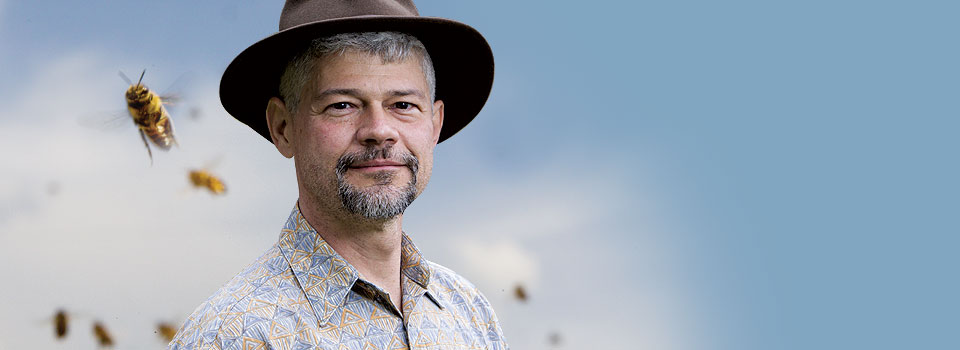Keith Delaplane, a professor in the College of Agriculture and Environmental Science’s department of entomology and director of the UGA Honey Bee program, is in his fourth and final year of leading a national consortium tasked with finding the source of the honey bee decline.
In 2006, beekeepers began reporting that once-thriving colonies of honey bees were being abandoned overnight. The phenomenon that became known as Colony Collapse Disorder was unusual because no dead bees were found outside the hives-the bees simply vanished. Beekeepers reported losing anywhere from 30-90 percent of their hives. Such dramatic losses spurred continuing press coverage, particularly when no single cause for CCD could be identified. But honey bees were already on the decline before CCD. The number of managed honey bee colonies has dropped from five million in the 1940s to 2.5 million today, according to the U.S. Department of Agriculture’s Agricultural Research Service.
This decline is significant because honey bees pollinate $15 billion worth of crops annually. That includes fruits, nuts and vegetables that humans eat as well as animal-feed crops, such as clover, which is fed to beef and dairy cattle. The ARS estimates that one-third of diets benefits directly or indirectly from honey bee pollination.
“We wouldn’t starve without honey bees,” said Delaplane, “but our diet would be a lot less interesting. That’s what’s at stake. It’s not human survival-but it is the quality of food that we enjoy and the quantity of it. If we don’t have pollination to produce these things, we’re going to see supply go down and prices go up.”
Honey bees are not the only pollinators available, but they are the best option for an industry that requires enormous input. Consumers expect fruits and vegetables to be available all the time, so every year, commercial beekeepers haul their colonies across the country to pollinate everything from almonds in California to blueberries in Maine.
“Because we have such high concentrated food production needs, we need to have high concentrated pollination inputs as well,” Delaplane said. “The honey bee remains the only pollinator that we can manage at a factory scale.”
But large-scale pollination means intermingling and potential exposure. Whatever honey bees are exposed to is taken back to their hive, making them vulnerable. “It’s just a perfect recipe for disease transmission,” he said.
Delaplane is the national director of the $4.1 million Managed Pollinator Coordinated Agriculture Project, or CAP, funded by the USDA’s National Institute of Food and Agriculture. The team involves 17 cooperators and institutions from coast to coast, a consortium of scientists and educators working to reverse honey bee decline.
“It’s expected that we will come out with answers to actually help the beekeeping industry,” he said, but the answer is likely to be just as complicated as the problem. From the beginning, we knew that this was not going to be a smoking gun, single cause, simple model.”
He believes there is no one single cause for honey bee decline, but he’s convinced that Varroa mite is at the top of the list of problems. At least three international symposia on this topic have been called in the last 16 months. Varroa destructor spreads and activates viruses, compromising the honey bee immune system. It’s native to Asia, but has been in the U.S. since 1988.
“I call it the snowball that starts the avalanche. It’s always at the top of the list,” he says. “If there was one thing I could wave my magic wand and cure, it would be Varroa mite. If we could get rid of Varroa mite, I think the headlines would cease.”
Some members of Delaplane’s CAP team are working to address Varroa mite by using RNA silencing technology, the process of inserting genetic material that blocks the production of proteins or other materials needed to live-killing the organism.
Others are narrowing down a list of viruses that may be problematic. They started with 10 and have narrowed it down to four. And the Nosema parasite, once thought to be a significant factor in honey bee decline, has been downgraded.
One of the team’s most significant findings involves what happens when hive chemicals-added by beekeepers to control parasites-interact with agricultural pesticides. One particular hive chemical is deadly when combined with a common agricultural fungicide. “Both of these chemicals by themselves are innocuous to the honey bee, but you put the two together and this horrible synergy happens that’s just lethal to bees,” he said.
Ultimately, the answer to honey bee decline is going to be addressing a number of big issues like Varroa mite and viruses, but also making policy changes at the level of the Environmental Protection Agency. “We still have farmers that’ll go out and spray a crop that’s blooming. If it’s blooming the bees are coming from everywhere, and you get these massive die-offs,” he said. “That’s an education issue, but it’s also an EPA issue-we’ve got to get that language on the label to make it unlawful to spray while a crop is blooming.”


